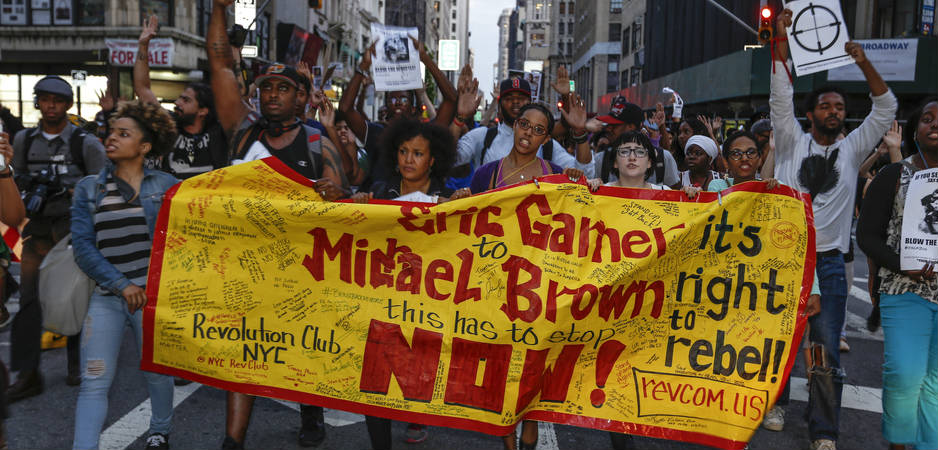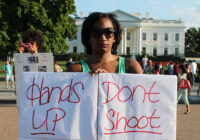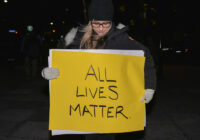The US must urgently address the historical and ongoing problem of police violence against communities of color.
On August 9, Michael Brown, an 18-year-old African American male, was shot and killed by Officer Darren Wilson in Ferguson, Missouri. To many, this may sound like a tragic accident. Others may assume it was simply the manifestation of crime and punishment. In reality, the death of young men of color at the hands of United States law enforcement is a continuous, systematic destruction of personhood that reaches back far beyond the birth of Brown. As Carimah Townes explains: “The civil unrest in Ferguson is not a random, isolated event, but the product of ‘racial segregation, economic inequality and overbearing law enforcement’ in the town. And it is a continuation of a legacy of civil unrest in communities of color throughout America.”
Details vary, and investigations are ongoing, yet reports from eye witnesses suggest the young man was neither armed, nor threatening when he was shot. In fact, eyewitness reports state that Wilson attempted to detain Brown by grabbing him by the neck and pulling him into the squad car; when Brown resisted, the first shot was fired. After Brown was shot the first time, he broke free, running from the vehicle. Witnesses, including Tiffany Mitchell and Dorian Johnson, note that he was then shot several more times despite turning, getting on his knees and raising his hands in the air to surrender.
Conflicting accounts, including that of Wilson, claim Brown turned and advanced upon him, causing the police officer to discharge several shots until the teenager could no longer walk. In either case, Brown bled out into the Ferguson concrete, uncovered and without an ambulance called. A recently released autopsy found that Brown was shot at least once in the top of the head. Crowds immediately gathered, screaming for the body of the dead teenager to be covered, and demanding answers as to why an ambulance was not immediately called to the scene.
Police violence has come in waves throughout Ferguson, slowed somewhat, largely as a result of responsibility being shifted from local police units to the Missouri State Highway Patrol. Days after Brown’s death, and once Wilson fled the city and before any investigative details were released, reports were made that the teenager may have been affiliated with a local robbery. Community members, and those across the country watching the details unfold, inquired over why more efforts had been made to link Brown to robbery rather than to investigate his death. Some have accused the Ferguson Police Department of attempting to taint the victim’s image as a justification for what can only be called an execution; essentially, a game of respectability politics. More are asking the question: Even if he did commit the robbery, how does that justify shooting an unarmed, surrendering teen?
By donning military gear and carrying war grade weapons, police conveyed an unspoken message that Ferguson was, at that time, an “us vs. them” space — or rather, a war zone.
Responding to the incident, local police militarized, arming themselves with M-16s and tanks. Rather than work collectively with the public and recognize that Brown’s death could serve as a catalyst to years of racial tension between police and civilians in Ferguson, county and local law enforcement armed themselves for a situation that cannot be described as anything other than warfare. This fear of retaliation was rooted in an assumed criminality and aggression of communities of color. Yes, race is a factor in Ferguson. Coupled with an already troubling history of brutality and questionable accountability processes, the tragic death of Brown cannot be viewed in a vacuum; the US must urgently address the historical and ongoing problem of police violence against communities of color.
This Is Not a New Problem
Police-sanctioned violence is not a new phenomenon in the US. The country’s history is wrought with the stains of blood left from batons, fists and hoses wielded against protesters. Communities of color have long suffered as targets of violence, based on years of socialization, categorizing them as aggressive criminals more apt to commit crimes than others, despite statistics that prove otherwise. Coupled with New York’s controversial “stop and frisk” policy, and similar narratives from cities across the US, racial profiling and assumptions of guilt are a widespread problem.
Though young men of color have been victims of police violence for centuries, we have seen increased reports come forth, largely due to the use of cellphone recordings and a push for police forces to acknowledge the racial disparities in stops and arrests. In July, Eric Garner was stopped by NYPD officers, placed in an unauthorized chokehold and suffocated to death. Iris Baez challenges the New York Police Commissioner’s dismissal of race in her CNN opinion piece: “Dismissing that race was a factor in Garner’s death is a slap in the face to those of us who’ve lost our children, and it is part of the problem that allows such unjust killings to continue.”
The strategy of criminalizing people of color is a historically successful narrative that is used to justify profiling, force and inequitable protections. While property destruction, police altercations and raucous crowds in places like Ferguson are coined as riots, the same actions in Chicago’s Wrigleyville neighborhood after the Blackhawks won the Stanley Cup in 2013 are simply viewed as a “spontaneous celebrations.” A notable difference: most of the “celebrators” were white, and none were calling for accountability on the part of the police.
The list of names ignored by some and memorialized by others, depicting years of death at the hands of police officers, is both heartbreaking and unending. These are not isolated incidents; these stories are the product of fear, systematized racism and unchecked power. Consider:
1) Birmingham Civil Rights protests in 1963
2) Stonewall Inn in 1969
3) Seattle’s WTO protests in 1999
4) Oscar Grant, shot in the back and killed in 2009
5) The treatment of university “occupy” protesters in 2011
6) Brooke Fantelli’s unwarranted tasering in 2011
7) NYPD’s suffocation (read: murder) of Eric Garner in 2014
This non-comprehensive list only grows. As Evette Dionne so painfully states: “It’s clear that open season on Black folks is just beginning.”
Militarization as Protocol
Overt militarization as a response to warranted civil unrest is not a new problem either. In the case of Ferguson, police were immediately militarized based on the assumption that the community would become violent, dismantling opportunities for community healing and dialogue, and intimidating grieving civilians. By donning military gear and carrying war grade weapons, police conveyed an unspoken message that Ferguson was, at that time, an “us vs. them” space — or rather, a war zone.
Police-sanctioned violence is not a new phenomenon in the US. The country’s history is wrought with the stains of blood left from batons, fists and hoses wielded against protesters.
Nick Wing from The Huffington Post breaks down former US Marine Paul Szoldra’s description of the equipment law enforcement used in Ferguson, including “short-barreled 5.56-mm rifles with high-powered scopes, six extra magazines, loaded with 30 rounds each, heavy body armor, military camouflage, and all of this riding around in armored trucks resembling mine-resistant vehicles used on the battlefield.” Wing goes on to explain that several combat veterans have reacted to the overt militarization of Ferguson, stating: “The SWAT officers are more heavily armed and outfitted than they themselves were while patrolling the streets of Iraq or Afghanistan.”
Colleen Curry from ABC News analyzes this trend of extreme force in her article, “Ferguson Police Are a Small Army, and So Are Thousands of Other Police Departments,” where she quotes a US Department of Defense (DoD) official stating that last October, Ferguson police received “non-tactical” equipment under the so-called “1033 program.” The program, initiated in the 1990s, allows the DoD to distribute surplus military weapons and gear to local police districts on a first-come, first-serve basis, at no cost. The DoD official explained to ABC News that the armored vehicles used by local law enforcement in Ferguson were not military ones, and that the camouflage uniforms were likely commercially purchased.
Senator Claire McCaskill [D-MO] critiqued the decision of approaching these situations while outfitted in military gear: “We need to de-militarize this situation. This kind of response by the police has become the problem instead of the solution … my constituents are allowed to have peaceful protests, and the police need to respect that right and protect that right.” As unchecked power can often lead to unnecessary force, Ferguson community members found themselves tear gassed in their own yards, and reporters were both assaulted and arrested for utilizing their First Amendment rights. Paul Szoldra poses the question in Business Insider: “When did ‘protect and serve’ turn into ‘us versus them’?” Restricting media coverage and implementing a no-fly zone over the area, which many assume was to limit air coverage of the scene below, only furthered tensions on the ground.
When Personhood Disappears
Deconstructing the humanity of one’s community only creates avenues for violence to be justified. If law enforcement can rationalize people as nothing but an oppositional force, rather than individuals composed of contextualized stories and influenced by histories, then those people become easier to violate without having to recognize their humanity.
One must wonder why local law enforcement felt compelled to convey the image of combat readiness, unless they had already made assumptions about how they would move forward when interacting with community members. The combination of military grade weaponry and an allowance for police to have unchecked authority could also have contributed to officers’ mentality that they were in a warfare scenario, rather than serving as peacekeepers to a community that just lost a child to unwarranted gunfire.
Author and Washington Post reporter Radley Balko explained this psychological shift to ABC News, stating: “When you arm police like soldiers and outfit them with military weapons and train them on military tactics and tell them they’re fighting a war, whether it’s a war on crime or drugs or looters and rioters, they’re going to start seeing themselves as soldiers, and seeing the people they serve less as citizens with rights and more as potential threats, and that’s what we’re seeing.” As a former marine, Szoldra explains: “If there’s one thing I learned in Afghanistan, it’s this: You can’t win a person’s heart and mind when you are pointing a rifle at his or her chest.”
A Moment Into a Movement
Now that police forces have stepped back and allowed the seemingly much more supportive Highway Patrol to take the lead, it is still important to analyze why this militarization was allowed and keeps occurring despite public protest. Advanced weaponry is created for instances of war, so one must ask: Why are we treating civilians like war combatants? Particularly when these measures often prohibit the exercise of First Amendments rights to gather, protest and speak? These are the same rights that police officers have sworn to uphold.
The assault first, question (much) later denial of individual rights and protections methodology we saw enacted in Ferguson is much more reticent of Guantanamo Bay, than what one would expect in 2014. Yet the unfortunate reality is these war tactics have been used against communities of color for years, imposing power to incite fear and quell uprisings. Again, this is not a new strategy. If a community can be painted as inherently violent, structures of power are then able to justify unequal treatment, punishment and imprisonment, despite the fallacy of their initial premise.
While assumptions of criminality, and visions of weapons that can never be found, are often attributed to members of the black community, violence is not exclusively saved for them. All people of color, the queer and trans communities, and many others are disproportionally at risk of police violence. The reach of power abuses know no bounds, as is depicted by the tragic death of Kelly Thompson from Fullerton, California. A community problem requires a community response.
From the Black Panther Party to recent shifts in university sexual assault policies, youth are often a core component in movement building. Responsible for thought-provoking campaigns and innovative new tools, youth are creative, pro-active resistance to the ever-present threat of assault on their bodies. Yet for a moment to become a movement, communities must collectively stand against unwarranted violence, whether those communities view themselves as directly affected or not. As Martin Luther King Jr. once proclaimed: “None of us is free, until all of us are free.”
The decrease in police militarization of Ferguson is not the end of this story. Arresting, trying and convicting Officer Wilson will not be the end of this story, just as it has not been for the victims and families that came before Brown — many of whom did not receive justice for their loss. For the US to begin addressing systematic abuses of law enforcement, we must be willing to take a critical look at how power, violence, masculinity, identity and poverty intersect. We must unlearn the dangerous and inaccurate assumptions we have about ourselves and our neighbors, if we want to keep ourselves and our children safe.
The views expressed in this article are the author’s own and do not necessarily reflect Fair Observer’s editorial policy.
Support Fair Observer
We rely on your support for our independence, diversity and quality.
For more than 10 years, Fair Observer has been free, fair and independent. No billionaire owns us, no advertisers control us. We are a reader-supported nonprofit. Unlike many other publications, we keep our content free for readers regardless of where they live or whether they can afford to pay. We have no paywalls and no ads.
In the post-truth era of fake news, echo chambers and filter bubbles, we publish a plurality of perspectives from around the world. Anyone can publish with us, but everyone goes through a rigorous editorial process. So, you get fact-checked, well-reasoned content instead of noise.
We publish 3,000+ voices from 90+ countries. We also conduct education and training programs
on subjects ranging from digital media and journalism to writing and critical thinking. This
doesn’t come cheap. Servers, editors, trainers and web developers cost
money.
Please consider supporting us on a regular basis as a recurring donor or a
sustaining member.
Will you support FO’s journalism?
We rely on your support for our independence, diversity and quality.








Comment